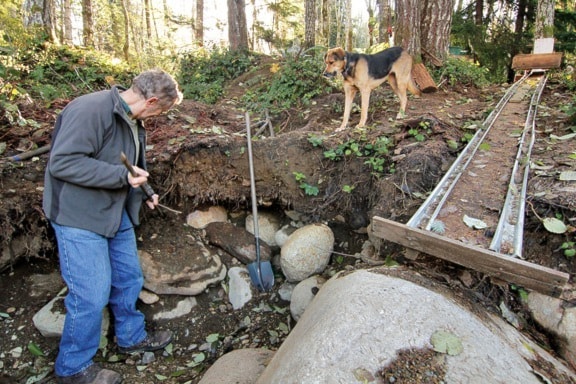Vancouver Island had a gold rush once.
When the precious metal was discovered in the Leech River in 1864, prospectors stampeded onto southern Vancouver Island.
The rush sparked the birth of Leechtown, a community nearly as short-lived as the gold rush itself. Leechtown's population mushroomed to about 5,000, but by 1866 most of the gold was gone with the people who left behind a virtual ghost town.
"There was 200,000 ounces of gold taken off the Leech River in a year," said Barry Foster, a Nanaimo placer miner. "It was one of the fastest-growing, fastest-dying gold rush towns in British Columbia and almost nobody knows about it."
Foster has panned rivers and dug for gold for 34 years. He has a placer claim on the Leech River, but the one he works is near the banks of the Nanaimo River. The site has been worked on and off for 80 years.
Island gold is either panned from rivers or placer mined.
Placer mining is a type of surface, or open pit, mining where tiny flecks of gold – even nuggets if you're lucky – are sifted out of gravel deposits.
Island placer mines are tiny operations, limited by environmental regulations to using hand tools. Machinery is prohibited.
There are dozens of claims staked out on central and southern Vancouver Island where the rivers flow through gravel deposits.
The tales and legends of up B.C.'s gold rush history draw gold hunters as much as the metal itself.
Foster caught gold fever from stories told to him by Bill Barlee, a former B.C. agriculture minister best known as the historian who hosted the TV series Gold Trails and Ghost Towns, which aired from 1986 to 1996.
"He was my neighbour," Foster said. "What chance did I have? That's the man I had sitting beside me a lot, talking to me. It was really great to have him around. He taught a lot of people and I was lucky enough to be one of them."
With current high gold prices, Foster said people could earn livings sifting it out of the ground.
But mining is just one way to earn a living with gold.
Ian Jensen, owner of Comox Valley Gold Adventures, runs gold-panning excursions that draw people from as far off as Europe.
"Everyone's looking for a new kind of outdoor activity," Jensen said. "So for tourism, it's huge."
One man from Washington, D.C., visiting Vancouver with his wife on their 30th wedding anniversary, booked a half-day panning excursion.
"I don't know how he talked his wife into it, but he flew from Vancouver to Campbell River," Jensen said. "I took him out for a half day because that's all he had time for and got him back to the airport. People get the bug in them."
Jensen brings gold-bearing gravel to schools to teach children gold panning and the role gold played in B.C.'s early economy. He plans to host free gold-panning field trips for schools.
Foster wants to use the experience and excitement of gold mining to direct children from broken families toward positive interests.
Last summer he hosted free afternoon outings at the claim for about 100 children and their mothers. He takes up to eight children per outing who take home the gold they've panned along with some knowledge about B.C.'s history.
"Every child leaves my camp knowing the history of British Columbia and how gold made a difference in opening up the area," Foster said.
Following up tales and legends to hunt for gold or just reading the land to discover spots it might be hiding can be as much fun as finding it.
Walking out of his Nanaimo River claim, Foster points out a stand of poplars about 30 metres away.
"That used to be a river bed," he said. "The rivers are where the gold is. Follow the poplars and you'll find the gold."
More people are joining the hunt.
Statistics from the B.C. energy and mines ministry show 490,000 hectares of the province are now under placer claims and leases - almost double the 250,000 hectares under placer titles in December 2005.
People don't need to have their own claim to pan for gold.
The Vancouver Island Placer Miners Association has three claims on the Leech River for members who don't hold claims. The association has about 90 members and is active year-round with meetings, rock and gem shows and guided outings to the claims through the summer and fall.
Donna Chaytor, association spokeswoman, said the river flushes more gold onto the claims each winter, effectively renewing the supply annually, so there is always gold to be panned.
She describes successful placer mining as blend of geology, location and knowing how to read a river.
"It is also one of the very few ways an individual can actually go out with sweat equity and make himself a few dollars, once he has earned the intricate art of placer mining – and it is an art," Chaytor said.
There is a wealth of information about placer mining, B.C.'s gold mining history, including Leechtown and Vancouver Island's gold rush, plus links to other placer mining associations across the province, on the Vancouver Island Placer Mining Association website at www.vipma.ca.
